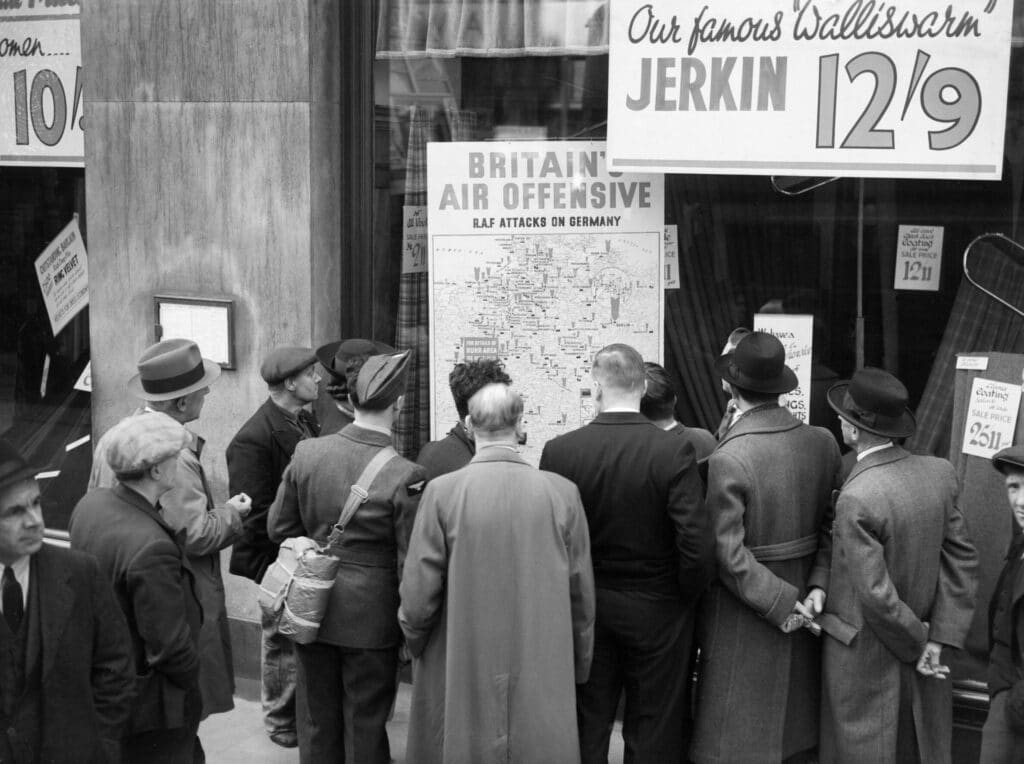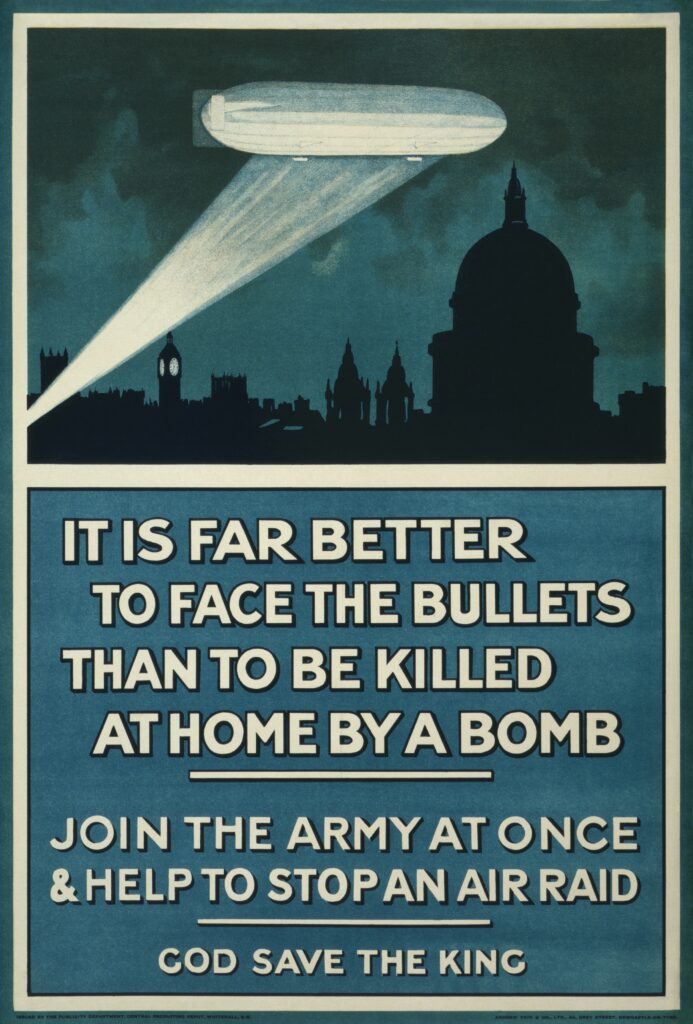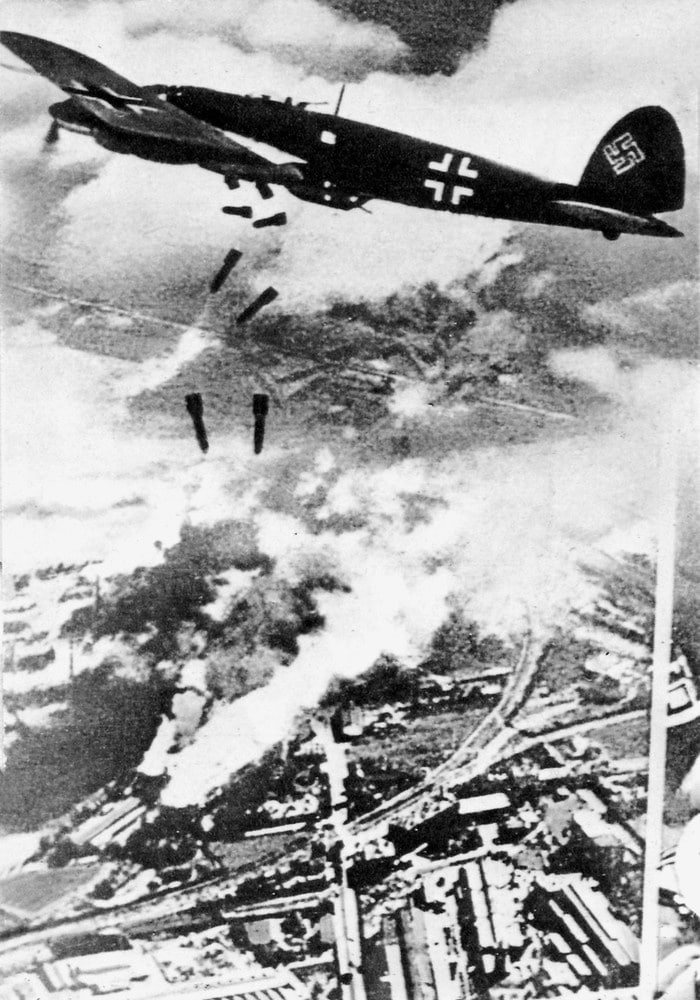This Week in History recalls memorable and decisive events and personalities of the past.
25th August 1940 – Second World War: The first bombing of Berlin by Britain’s Royal Air Force

People in London look at a map illustrating how the RAF is striking back at Germany during 1940
The First World War had seen the world’s first strategic bombing campaign from the air. German Zeppelins, beginning in January of 1915, rained bombs on British cities and sowed panic and paranoia among the British population.

First World War British poster of a Zeppelin above London at night
Some 557 people would be killed by Zeppelins, which proved only moderately effective and became more vulnerable to being shot down and less effective as the war went on.
In 1917 the Germans replaced most of their Zeppelin bombers with more familiar fixed-wing aircraft. Though Zeppelin bombing raids would continue for rest of the war, the new bombers would be more effective, killing 857 people and proving harder to shoot down.

Zeppelin-Staaken bomber
So impactful was the bombing campaign on the psyche of the British government that, in 1918, a British parliamentary inquiry was appointed – it was led by South African Jan Smuts – to look into defending cities against aerial bombing. The report of the inquiry would ultimately lead to the creation of the Royal Air Force as an institution separate from the army and Royal Navy.
Ultimately the destruction wrought by the German raids during the First World War was fairly mild by the standards of the toll elsewhere in the confict. However, with the rapidly advancing pace of aeroplane technology, many political and military leaders at the end of the war feared that any future conflict would see entire cities destroyed from the air and that this was impossible to defend against.

Stanley Baldwin
The British Prime Minister, Stanley Baldwin, would declare in a speech in 1932: ‘The bomber will always get through.’ These fears would drive the development of key innovations such as radar, a technology which proved decisive for the British in the Second World War.
During the interwar period, the terrifying power of aerial bombardment was demonstrated in a variety of conflicts. The Italian Air Force bombed Ethiopian cities during the Italian conquest of Ethiopia, and both sides in the Spanish Civil War would use aerial bombing to try to break the will of their opponents. The most horrifying use of bombers, however, was in the Second Sino-Japanese War of 1937, when Japan carried out a relentless bombing campaign over Chinese cities.
At the outbreak of the Second World War, Germany extensively used bombing of cities as a key part of its strategy to smash the morale of its opponents and destroy their industry. Warsaw was extensively bombed during the initial German invasion in 1939.

German Heinkel He 111 planes bombing Warsaw, September 1939
Other cities across the region conquered by Germany were also extensively bombed, most infamously Rotterdam, a city which had already surrendered.

Rotterdam, after the raid
British cities were also bombed from the start of the war. The British would only manage to carry out their first bombing raid against a German city in May 1940.
Slowly but surely, the air war began to change in the Allies’ favour.
In July 1940, the Battle of Britain began, as the German Luftwaffe attempted to destroy the Royal Air Force to open the door to a possible seaborne invasion of the British Isles. This included bombing mostly military targets at first, but would steadily incorporate more and more civilian targets, culminating in the Blitz, which saw British cities heavily bombed between September 1940 to May 1941.

A German Luftwaffe Heinkel He 111 bomber flying over Wapping and the Isle of Dogs in the East End of London at the start of the Luftwaffe’s evening raids of 7 September 1940.
As the Battle of Britain raged, the British were expanding their own bombing campaign against Germany, with attacks on cities and logistics. On 25 August 1940, 96 bombers of the Royal Air Force launched a raid on Berlin for the first time. The attack was fairly unsuccessful, but greatly worried Hitler, who had made promises to his population that Germany would be safe from bombing. Hitler would order his air force to focus more on bombing cities from then on, as retaliation, leading to the Blitz.
British air power continued to grow as the war progressed, and German airpower diminished, as it was both increasingly outmatched by the Allies and overstretched, having to defend much of Europe while also supporting the invasion of the Soviet Union. The entrance of the United States, with its huge manufacturing output, into the war in December 1941 only grew the power of the Allies in the air.
The head of British Bomber Command, Sir Arthur Harris, would declare in 1942: ‘The Nazis entered this war under the childish illusion that they were going to bomb everybody else and nobody was going to bomb them. At Rotterdam, London, Warsaw and half a hundred other places they put their Hun fury into operation. They sowed the wind and now they are going to reap the whirlwind.’
By the end of the war, the British and Americans were carrying out massive air raids on German cities, laying waste to enormous areas.
A film shot by the US Air Force in July 1945, showing the destruction in central Berlin
This disrupted the German war economy and saw almost the entire German air force pulled away from the fighting in the East where it was sorely needed to battle the Soviets.

Cologne in 1945. Despite being hit dozens of times by Allied bombs, Cologne Cathedral survived the war
Over the course of the war, 60 000 British civilians would be killed in bombing and around half a million German civilians and slave labourers.
If you like what you have just read, support the Daily Friend

